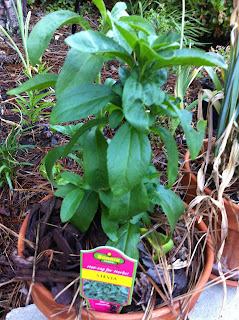Nothing beats the taste of fresh herbs. And if these herbs are from my garden...its even better. Everytime, I pinch off few mint leaves to garnish a tall glass of nimbu paani or grab a stalk of basil from my garden for some fresh pesto, it gives me a small sense of pride. Its so easy to grow herbs! Here is a list of herbs that can be grown in your garden or patio for some instant bragging rights.
Couple pointers :
1) Most herbs are happy when grown in a pot. Be careful when putting mint or other invasive herbs directly in the garden, these will take over your yard and kill everything in sight.
2) Plant perennials and annuals in different beds.
3) Buy smaller plants which are much cheaper. They'll grow huge within few weeks.
Easy to Grow Herbs:
Basil: YEP ! you need one. Don't even think twice..it will pay for itself. Annual. Generally, if you cut from the top, you'll encourage bushier growth of your plant. If you cut from the bottom or sides, you'll encourage a taller, more slender plant. Don't chop more than one-third of total growth at any one time. Pinch off any flowers to stimulate growth.
 Mint: Grow this herb in a container. Super hardy and invasive. Try chocolate mint ( Yum), pineapple mint or peppermint. Do not over water.
Mint: Grow this herb in a container. Super hardy and invasive. Try chocolate mint ( Yum), pineapple mint or peppermint. Do not over water.
Stevia: Never heard about this one ??? Leaves have a sweet taste. Literally, pinch a leaf and chew on it. Natural sweetner. Noncarcinogenic unlike artificial sweetners. Leaves can be used fresh or dried. Give this herb some room to grow, it loves to spread out. Annual. Sidenote, Truvia is made from Stevia extract.
Rosemary: Workhorse. Newbies should start their gardening adventure with this herb. Super hardy, drought tolerant ( it actually hates too much water), fragrant, evergreen, perennial. No baby sitting required.
Thyme: Another workhorse herb. Super hardy. Perennial- comes back strong year after year. Survives freezing temps. Do explore lemon thyme and lime thyme herbs. A keeper in your garden.
Lemongrass: Its a grass so definitely pot this one. Stalks have mild lemony flavor. Also a great insect repellant. Annual but it can survive mild winters with heavy mulching. Perfect for a cup of Gavati Chaha-herbal cleansing tea.
Sweet Bay/Bay Laurel: A distant cousin of Tejpatta. Leaves have spicy flavor. Evergreen fragrant leaves you can pinch off even in winter. Slower growth. Can be potted or planted in the ground. During winter protect in ground plant from snow.
Oregano: Oregano spreads like mint. Perennial. Strong comeback every year. Thrives in poor soil and less water. Newbie, are you taking notes? This one should work for you as well.
Herbs that need babysitting...but you will still love them:
Dill and cilantro: Goofy herbs. These are cold weather herbs- good for early spring and fall. With higher temperatures, these will bolt early i.e. leaves become feathery and seeds develop. For southern gardens, cilantro and dill may work in partial shade with heavy mulching. But prepare yourself for droopy plants that die mid summer. Side note, Cilantro does not like to be transplanted.
Dill and cilantro: Goofy herbs. These are cold weather herbs- good for early spring and fall. With higher temperatures, these will bolt early i.e. leaves become feathery and seeds develop. For southern gardens, cilantro and dill may work in partial shade with heavy mulching. But prepare yourself for droopy plants that die mid summer. Side note, Cilantro does not like to be transplanted.
Curry Leaf Plant/Murraya koenigii: I'll fess up, I have killed one curry leaf plant by leaving it outdoors during winter. From what I read, this plant cannot tolerate temperature lower than 55 degrees. Grows well in Zones 9-11. All other zones need to bring the plant indoors during winter. Plant may or may not survive depending on humidity levels indoors. Sadly, this one is not for me. I'll continue to buy sprigs of curry leaves from my Indian grocery store.
Do you have any fav herbs??





